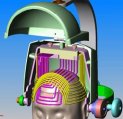 Deep transcranial magnetic stimulation (TMS) is a completely new method of manipulating the mind. Conventional TMS has been around since 1985 and used electromagnetic pulses that pass through a person’s skull into their brain. These pulses can then create an electric current in a very targeted brain region. Different pulses have different effects on the underlying brain tissue. High frequency electromagnetic pulses are able to excite brain activity, while low frequency pulses tend to decrease activity. The main problem with conventional TMS is that it can only reach approximately 1 or 2 centimeters into the brain. This leaves many brain regions unreachable. Deep TMS, however, is able to reach about 7 centimeters into the brain. This means that almost any brain region is within reach. The deep TMS can penetrate and selectively increase activity deep within the brain without overexciting regions closer to the skull. Having a brain manipulation tool with this selectivity may be used for a variety of brain disorders and also brain injury treatment.
Deep transcranial magnetic stimulation (TMS) is a completely new method of manipulating the mind. Conventional TMS has been around since 1985 and used electromagnetic pulses that pass through a person’s skull into their brain. These pulses can then create an electric current in a very targeted brain region. Different pulses have different effects on the underlying brain tissue. High frequency electromagnetic pulses are able to excite brain activity, while low frequency pulses tend to decrease activity. The main problem with conventional TMS is that it can only reach approximately 1 or 2 centimeters into the brain. This leaves many brain regions unreachable. Deep TMS, however, is able to reach about 7 centimeters into the brain. This means that almost any brain region is within reach. The deep TMS can penetrate and selectively increase activity deep within the brain without overexciting regions closer to the skull. Having a brain manipulation tool with this selectivity may be used for a variety of brain disorders and also brain injury treatment.
Researchers are currently testing deep TMS in a clinical trial to improve the performance among stroke patients. Deep TMS is a powerful tool that can shape the brain through neuroplastic mechanisms. For that specific study, researchers are testing TMS for efficacy and safety in treating ischemic stroke. Ischemic stroke is caused from a blood clot localized in a person’s brain. TMS can cause an increased in brain growth factors like brain derived neurotrophic factor (BDNF). BDNF may allow neurogenesis (the growth of new neurons) and also the sprouting of neuronal axons. This might be expected to speed the recovery among stroke patients. Transcranial direct current stimulation and deep brain stimulation may also be used in the future to do this.